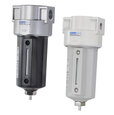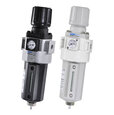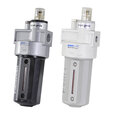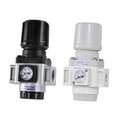FRL Unit: Filter, Regulator, & Lubricator - How They Work
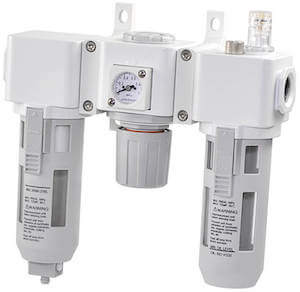
Figure 1: FRL unit
Filter, regulator, and lubricator (FRL) units in compressed air systems provide clean air at a consistent pressure. They are lubricated when needed to ensure the proper functioning of pneumatic components, thereby extending their operational lifespan. The air supplied by compressors is frequently contaminated, over-pressurized, and lacks lubrication, making an FRL unit essential to protect equipment from damage. Filters, regulators, and lubricators can be purchased separately or as a combined unit (as shown in Figure 1) based on the requirements to meet the correct air specifications for downstream equipment. Install an FRL unit when:
- Using pneumatic tools and equipment
- installing an HVAC system
- delivering clean air to the workplace
- requiring compliance with ISO, OSHA, ASHRA, or other air quality standards
- improving an air system's service life, safety, and reliability
Table of contents
- What is an FRL unit
- What FRL components are necessary?
- Application specifications
- Pneumatic filter selection
- Pneumatic pressure regulator selection
- Pneumatic lubricator selection
- FAQs
View our online selection of filters, regulators & lubricators!
What is an FRL unit
An FRL unit comprises a filter (F), regulator (R), and lubricator (L). These individual units can combine into one unit to ensure clean air in a pneumatic system. It is also possible to use each component individually. A proper air filter, regulator, and lubricator unit in a pneumatic system provides higher reliability of the components downstream, reduced power wastage from over-pressurization, and increased component lifetime. The three components in an FRL unit work together.
- Filters: Filters remove water, dirt, and other harmful debris from an air system, which is often the first step in improving air quality.
- Regulators: The second step in an FRL system is a regulator. Regulators adjust and control the air pressure of a system to ensure that down-line components do not exceed their maximum operating pressures.
- Lubricators: Lubricators reduce the internal friction in air tools by releasing a controlled oil mist into the compressed air. This is often done last and/or right before the component that needs lubrication.
What FRL components are necessary?
Filter, regulator, and lubricators are available individually or as a combined air filter-regulator (FR) or filter-regulator-lubricator (FRL) unit. Install an air compressor filter and regulator unit if the equipment is self-lubricating and an FRL unit if the equipment requires lubrication.
It is essential to understand the air requirements of the system and components to determine the selection of individual components of an FRL unit for an application. The FRL components necessary depends on the system requirements. However, ensure that every air system uses at least one filter and one pressure regulator. Most modern pneumatic tools use self-lubricating seals, and the user often does not need to install a separate lubricator. If a tool isn’t self-lubricating, also install a lubricator in the system. As a general rule, a pneumatic system’s order of installment is: a compressor, filter, regulator, and lubricator. Give careful consideration to the order and location of these devices.
Application specifications
Before selecting an FRL unit, it is important to consider a few system parameters:
- pressure
- flow rate
- air quality requirements of the tools using compressed air
- if any air quality standards apply to the workplace
To ensure that the FRL unit, or one of its components, meets the pressure ranges in and out of the flow rate requirement (typically in liters per min), consult the datasheet for the specific unit.
Consider the environment around the device. Housings come in different materials to accommodate different environmental conditions.
- Choose a metal housing if the device is outside and exposed to heat, salt water, salt air, or chemicals.
- Use Nylon or polycarbonate housing for most general applications.
Read our chemical resistance guide for more details on the material compatibility for each application.
Pneumatic filter selection

Figure 2: Pneumatic filter
Filters remove water, dirt, and other harmful debris from an air system (Figure 2). Two factors determine a filter’s necessary micron size and bowl material: contaminants’ type and size and components’ air requirements. Common applications typically require a filter rated between 5 - 40 microns. The filter rating gives the particle size limit that the filter allows to pass through. For example, a 20-micron filter allows only particles smaller than 20 microns to pass through.
Filters experience a slight pressure drop across the inlet and outlet ports due to flow restriction. Because it’s easier for contaminants to clog a 0.1-micron filter than a 40-micron filter, 0.1-micron filters create a higher pressure drop and require more maintenance. Therefore, do not oversize the filter by selecting the finest micron size, as it can lead to higher costs for the component, a larger pressure drop, and more maintenance time. Instead, choose a filter that will remove only the smallest contaminant specific to your system.
The bowl material and drainage type are also necessary to get right. The bowl comes into contact with the contaminants and houses the filtered particles. Therefore, the pressure, temperature, and chemicals present affect the bowl material selection. Filters also require drainage using an automatic, semi-automatic or manual drainage system. Or a condensate drain can attach to the outlet to remove the filtered contaminants.
- Automatic: An automatic drain is a 2/2-way valve that closes upon system pressurization. It has a float system that rises upon system depressurization or liquid accumulation. The float rising causes the drain to open. Choose automatic drainage when the equipment is in continual use, requires frequent drainage, or is in a hard-to-reach location.
- Semi-automatic: A semi-automatic drain automatically drains the system upon depressurization. It can drain a pressurized system, but only manually. Use a semi-automatic drainage filter if the system is only sometimes under pressure.
- Manual: It is possible to manually drain a filter in a depressurized system. However, do not choose manual drainage if the location is in a hard-to-reach location, the system requires frequent drainage, or the application doesn’t depressurize the system regularly.
- Condensate Drain: A condensate drain attaches to the filter’s outlet and drains it. However, ensure to set the opening/closing timings.
Pneumatic pressure regulator selection
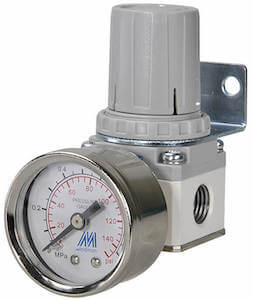
Figure 3: Pneumatic pressure regulator
Pressure regulators, also called pressure-reducing valves, adjust and control the system's air pressure to limit downstream pressure and protect downstream components. (Figure 3). Two of the most critical selection criteria for pressure regulators are the pressure rating and if it is a relieving or non-relieving regulator.
- Pressure rating: It is essential to include a safety factor on the maximum input pressure so that the regulator can handle excess pressure. In standard pressure regulators, a manual knob sets the output pressure. Typically, a regulator’s manual will have a flow curve that allows a user to correctly size a regulator based on the system flow rate and desired outlet pressure. Regulators also provide a consistent and stable outlet pressure. To regulate the pressure to 0.6 MPa, select a regulator having a maximum range of 1 MPa instead of 0.7 MPa to ensure that it does not damage the regulator if the system becomes over-pressurized. In addition, if the inlet pressure is too high for a single device, two pressure regulators in a row can be used to decrease the pressure in two stages.
- Relieving or non-relieving regulators: Relieving regulators have a built-in vent that lets excess pressure escape once it exceeds a certain threshold. Non-relieving regulators will not vent this extra pressure and rely on a secondary device to decrease pressure. For a non-toxic application, use a relieving regulator to ensure that a buildup in pressure doesn’t occur and cause damage. However, when the application consists of dangerous or expensive gasses, do not release them into the atmosphere.
Pneumatic lubricator selection

Figure 4: Pneumatic lubricator
Lubricators reduce the internal friction in tools or equipment by releasing a controlled oil mist into the compressed air (Figure 4). Knowing the pneumatic component’s need for lubrication will determine the oil type and drip rate (the amount of oil released downstream). There are two types of lubricators.
- Oil-fog: Oil-fog lubricators supply 100% of the oil seen in the sight glass downstream as a large droplet. It is suitable for short distances and typically just for one component requiring heavy lubrication.
- Micro-fog: Micro-fog lubricators supply roughly 10% of the oil seen in the sight glass downstream as a mist (< 2 µm). These lubricators are suitable for long distances and multiple components.
Lubricator maintenance is refilling the oil reservoir. Monitor the oil level through the sight glass or a window on the housing. Lubricators also need a pressure differential to make the oil drip. Therefore, they create a pressure drop at the outlet. Take this into account to ensure the proper pressure reaches the end component. This means the air will not be lubricated if the system is off, preventing oil wastage. Read our article on oiling pneumatic tools for more details on the different types of oil used in pneumatic systems and their selection criteria.
Note: Many pneumatic components are self-lubricating and don’t require any additional lubrication.
FAQs
What does FRL mean?
FRL stands for filter regulator lubricator. Filter, regulator, and lubricator (FRL) in compressed air systems deliver clean air at a fixed pressure and are lubricated (if needed) to ensure the proper pneumatic component operation.
What does a compressed air (pneumatic) filter regulator do?
An air compressor regulator and filter unit consist of a filter and an air regulator. The filter removes water, dirt, and other harmful debris from an air system. Pressure regulators adjust and control the air pressure of a system to ensure that down-line components do not exceed their maximum operating pressures.




